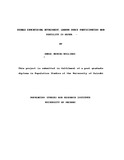| dc.contributor.author | Odege, Dorcas Williams | |
| dc.date.accessioned | 2014-01-30T08:24:42Z | |
| dc.date.available | 2014-01-30T08:24:42Z | |
| dc.date.issued | 1993 | |
| dc.identifier.uri | http://hdl.handle.net/11295/64420 | |
| dc.description.abstract | The main objective of this study is to provide the basis for
determining the potential demographic effect of female
educational attainment and labour force participation on reducing
fertility. The data used for the study is derived from KDHS
1989. The study examines the relationship which exists between
the independent variables (education and employment) and selected
fertility variables.
The methods of analysis used in this study include
percentages, cross tabulation and chi-square tests. The study
established that there are relationships between employment of
women and fertility. It also establishes the relationships that
exist between education and fertility.
It is concluded in the study that if women are highly
educated they will have the chance to persue job opportunities
which exist in the labour market, consequently this may change
their fertility behaviour. | |
| dc.description.abstract | | |
| dc.description.abstract | | |
| dc.description.abstract | | |
| dc.language.iso | en | en_US |
| dc.publisher | University of Nairobi | en_US |
| dc.title | Female Educational Attainment, Labour Force Participation and Fertlity in Kenya | en_US |
| dc.type | Thesis | en_US |
| dc.description.department | a
Department of Psychiatry, University of Nairobi, ; bDepartment of Mental Health, School of Medicine,
Moi University, Eldoret, Kenya | |

